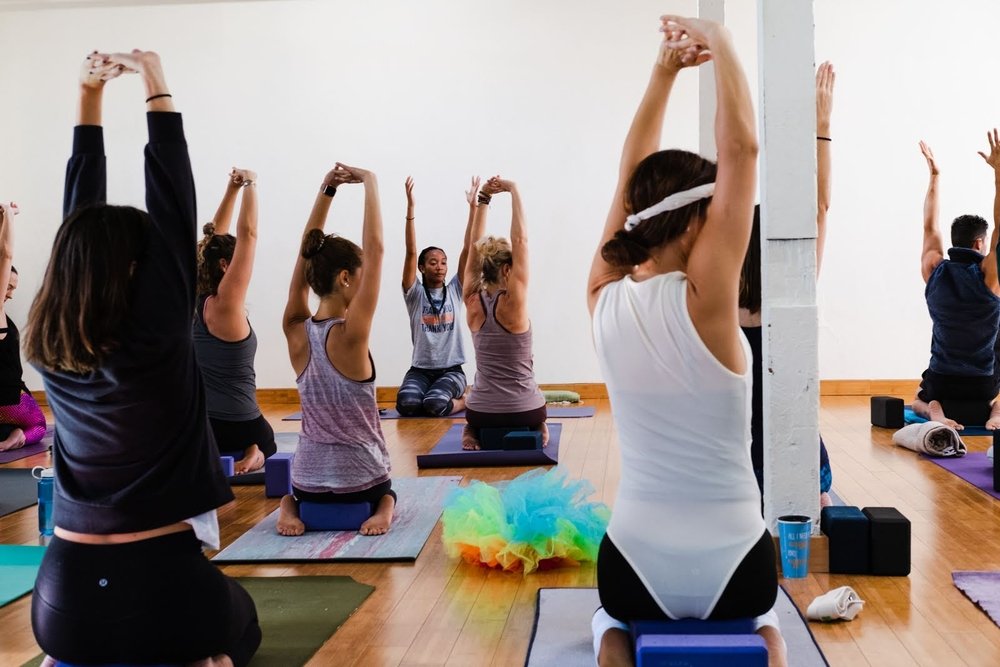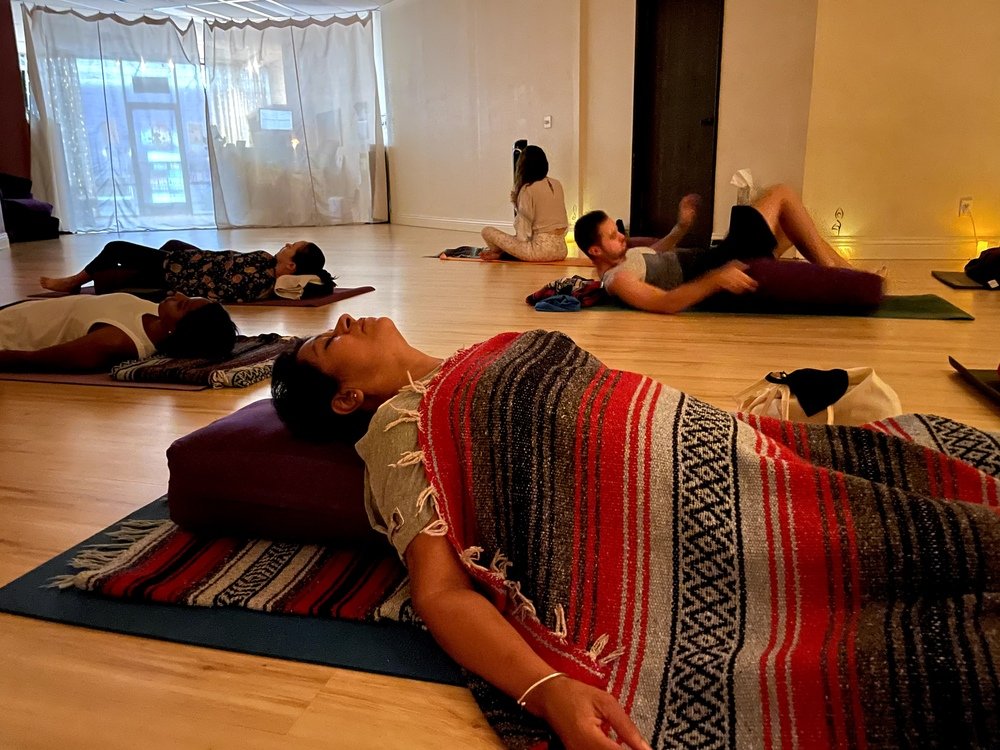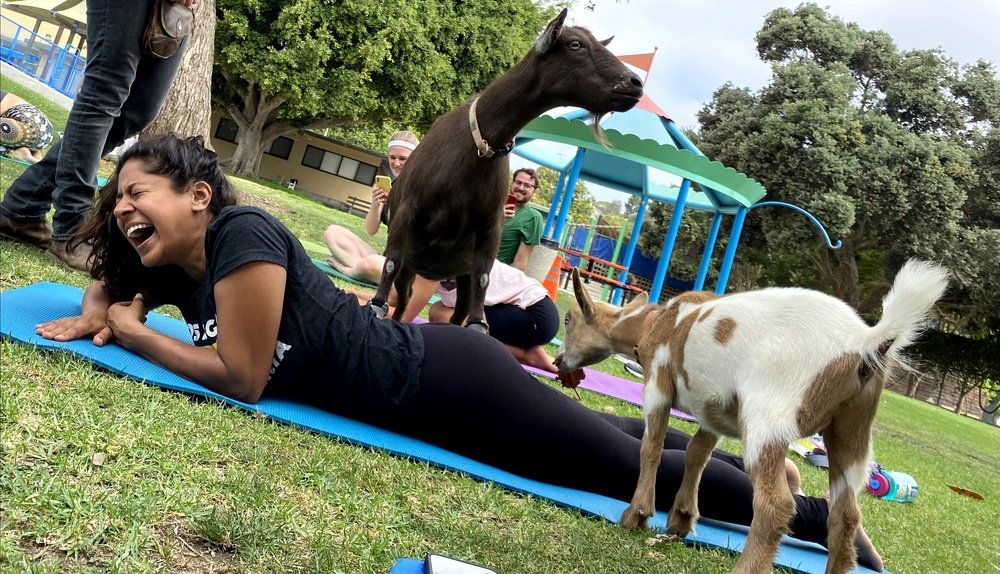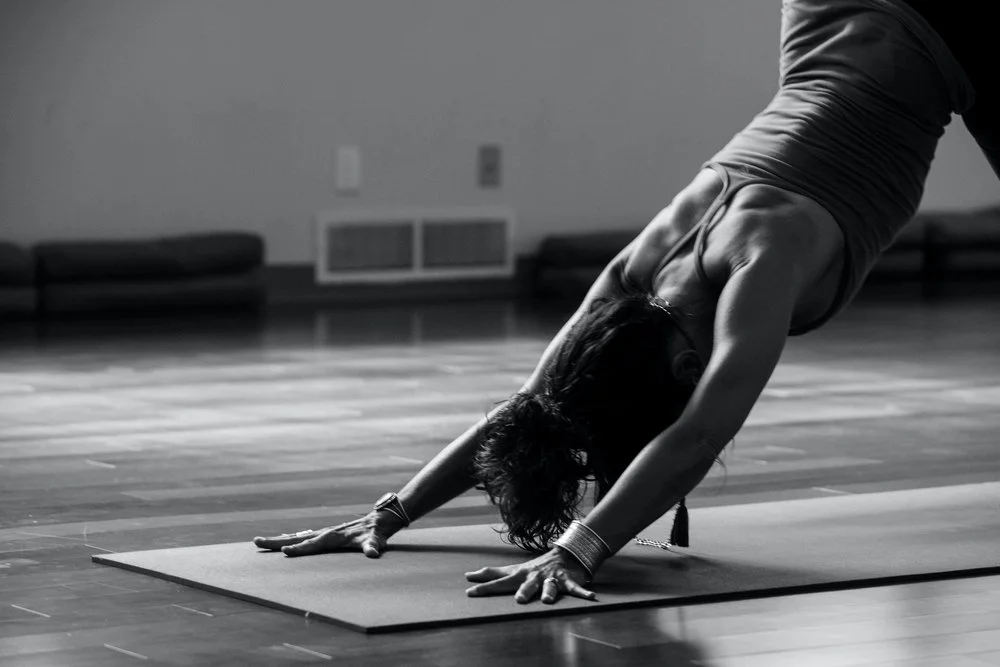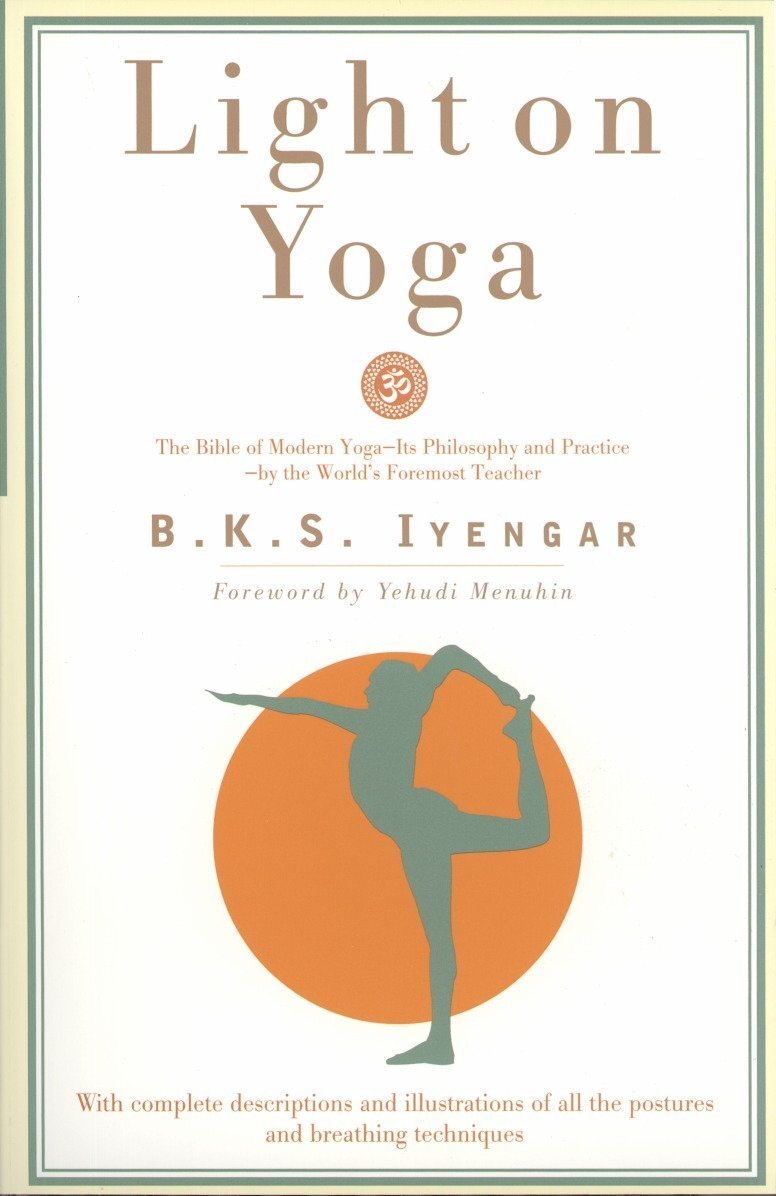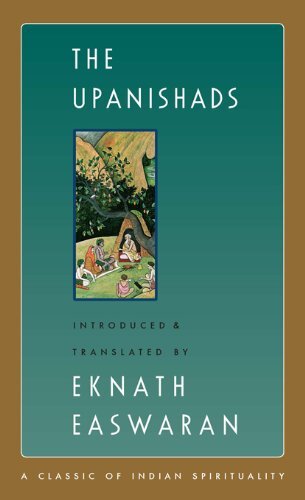15 Different Types of Yoga and Their Benefits
These 15 different types of yoga each have unique benefits
“The union of your individual self with the supreme Self is yoga.”
Yoga, the art of uniting mind, body, and spirit, offers a multitude of styles, each with its own unique advantages. I’ve been practicing yoga for over 15 years now, and have tried every possible yoga type at this point!
In this guide, I break down 15 different types of yoga and their transformative benefits to help you determine which yoga style is best for you. I will cover where each type of yoga originated, what its unique benefits are to our physical and mental health, and also provide you with my personal take on each style.
Whether you're a seasoned yogi or a beginner exploring this ancient practice, understanding the different types of yoga and their benefits can guide you on your personal journey.
HERE ARE 15 DIFFERENT TYPES OF YOGA AND THEIR BENEFITS:
1. Vinyasa Yoga
Vinyasa yoga, also known as "flow" yoga, emerged in the late 20th century in the United States. The history of Vinyasa yoga can be traced back to the teachings of two influential yogis, Tirumalai Krishnamacharya and his student K. Pattabhi Jois.
Known as the father of modern yoga, Krishnamacharya developed a dynamic form of yoga that emphasized linking breath with movement to create a continuous flow of postures. This form of yoga laid the foundation for what would later become Vinyasa yoga.
In the latter half of the 20th century, his student Jois, along with other Western teachers, inspired a generation of Western yogis to explore the principles of Vinyasa, leading to the creation of various Vinyasa-based styles.
With these influences, Vinyasa emphasizes a smooth flow of movements, transitioning from one pose to another in sync with the breath. It is one of the most popular styles of yoga in the West today.
Vinyasa yoga's fluidity makes it a popular choice for modern practitioners seeking a dynamic and invigorating experience. Known for its creative and flowing sequences, this style is ideal for those seeking an energizing practice that challenges the body and clears the mind.
Vinyasa yoga benefits: Vinyasa builds cardiovascular strength, enhances flexibility, promotes mindfulness, and makes you sweat.
My take: This style of yoga is the most common one I find in studios these days. These classes have a lot of downward dogs, chaturangas, lunges, and warrior positions.
The classes are tough and kick my butt every time! They are rigorous, fast-paced workouts, but you can find slower classes as well.
The common thread in all vinyasa classes is the flow - the graceful movement from posture to posture, coordinated with the breath and with minimal rest time in between. This makes it more aerobic and sweat-inducing than other types of yoga.
I leave this class feeling tired and sweaty, but more supple. This class is best suited for people who want to feel challenged and like they had an actual workout.
Here are a couple great Vinyasa yoga classes:
2. Hatha Yoga
Hatha Yoga traces its roots back to the 15th century in India. The word "Hatha" is a combination of two Sanskrit terms, "Ha" (sun) and "Tha" (moon), symbolizing the union of opposing energies. It was first introduced in the Hatha Yoga Pradipika, a classical text written by Yogi Swatmarama.
The primary goal of Hatha Yoga is to prepare the body for spiritual practices and meditation, as it emphasizes physical postures, known as asanas, and breath control, known as pranayama. Over the centuries, Hatha Yoga has evolved and been adapted into various styles that cater to different levels of practitioners. Hatha Yoga is the foundation of many other yoga styles.
Hatha yoga benefits: This yoga style is a great starting point for beginners. It focuses on building strength, flexibility, and mindfulness. The slow-paced nature of Hatha allows practitioners to cultivate a deeper mind-body connection, reduce stress, and improve overall relaxation.
My take: In my opinion, this class embodies the true spirit of yoga. You work your way through a bunch of classic postures, and go at a much slower and less intense pace than other styles.
These classes place more emphasis on the breath and meditation. I leave feeling blissful, and with a renewed sense of faith in the magic of the universe.
This is a great style for people who are new to yoga, or long-time students who want to reconnect with themselves and their practice.
Here are a couple great Hatha yoga classes:
3. Ashtanga Yoga
At the original yoga shala in Mysore, India where Ashtanga yoga was founded
Ashtanga Yoga is one of the most structured and physically demanding forms of yoga. It was developed by Sri K. Pattabhi Jois in the early 20th century, drawing from his guru and ancient yogic texts. Jois taught his Ashtanga Vinyasa yoga system throughout his life, attracting students from all over the world.
The practice follows a specific sequence of postures, known as the “Primary Series”, “Intermediate Series”, and “Advanced Series”, which are practiced in a flowing, sequential manner. In the traditional way of practicing, you must master each posture before you can advance to the next, and subsequently, you must complete each series before you can graduate to the next.
There are 2 ways to practice Ashtanga yoga:
Teacher-Led Class - The first is in a traditional led class where a teacher guides you through the sequence of postures.
Mysore Ashtanga Yoga - Named after the city of Mysore in India where Jois is from, this is a self-paced style of Ashtanga Yoga which allows practitioners to memorize and progress through the sequence at their own pace, while teachers oversee students and provide adjustments throughout their practice.
Ashtanga yoga benefits: This vigorous form of yoga builds stamina, tones muscles, and purifies the body through sweating. Ashtanga fosters discipline and self-awareness while promoting detoxification and cleansing.
My take: This is my go-to form of yoga, and the style I feel most connected to. I have studied with Jois’ daughter at his shala in Mysore, India for several weeks. The practice attracts students who are extremely disciplined and dedicated to their practice.
I find Ashtanga to be incredibly demanding, and you can spend a lifetime practicing everyday and still not master it. If you are an athlete, a person who likes to challenge and push yourself, or a person who wants more than relaxation from your practice, this is the yoga style for you.
After this class, I leave feeling totally exhausted but incredibly accomplished. The bone-twisting and pretzel-like postures make me feel like a sponge that has been wringed dry. The plus side is that my negative emotions leave my body with each twist and inversion in this class.
Because it is so taxing, I often have to take days off or have long lulls in my practice. But I always come back to the mat, and each time I’m reminded why yoga is one of the greatest joys of my life.
Here are a couple great Ashtanga yoga classes:
4. Yin Yoga
My first ever yin yoga class in Ubud, Bali
Yin Yoga is a relatively modern style of yoga, emerging in the 1970s. It was developed by martial arts expert and yoga teacher Paulie Zink, drawing inspiration from Taoist philosophy.
In Yin Yoga, practitioners hold passive postures for an extended period, usually three to five minutes, allowing for deep relaxation and targeting the connective tissues and fascia. This gentle practice complements the more dynamic and active yoga styles, offering a meditative and introspective approach to yoga.
Yin yoga benefits: This gentle practice improves flexibility, releases tension, and stimulates energy flow throughout the body.
My take: I absolutely LOVE yin yoga. It is one of my favorite styles when my body is craving a gentle, mellow, contemplative practice. Thankfully, there are no downward dogs or rigorous poses. You pretty much stay lying or sitting on the mat the whole time, which is pure heaven after a long day.
You hold each pose for 5 minutes or so, which sounds easy, but staying stretched out in positions for that long can be challenging for the body and mind, requiring you to breathe deeply as you release the tension. Despite that, I always leave feeling super relaxed and blissed out.
Yin Yoga is ideal for individuals seeking a calming and meditative practice. It’s perfect for when you are feeling low energy, in the evening time before bed, or when you want to nurture yourself while recovering from an injury.
Here are a couple great Yin yoga classes:
5. Iyengar Yoga
Founded by B.K.S. Iyengar, Iyengar Yoga is a precise and alignment-focused style of yoga that has gained worldwide recognition for its emphasis on precision in the postures. Props like belts and blocks are used to facilitate proper body alignment.
Iyengar faced poor health during his childhood, including malaria, tuberculosis, and typhoid, resulting in a frail and stiff body. At the age of 16, he began studying yoga under his brother-in-law, Sri T. Krishnamacharya. Through rigorous practice and dedication, he overcame his health obstacles and became a leading authority on yoga.
Iyengar’s innovative use of props revolutionized yoga teaching, making it accessible to people with different physical abilities and limitations. He published the seminal book, Light on Yoga, which became a landmark in the world of yoga literature.
The book contains detailed descriptions and photographs of over 200 yoga postures, along with information on breath control and yoga philosophy. It helped popularize Iyengar Yoga internationally, spreading its teachings and methodologies beyond India's borders.
Iyengar’s teachings attracted students from diverse backgrounds, including celebrities, athletes, and prominent figures in various fields. Today, Iyengar yoga is practiced and taught across the globe. Certified Iyengar yoga teachers undergo rigorous training and assessment to maintain the authenticity and high standards of the practice.
Iyengar yoga benefits: This yoga style helps improve body awareness and posture, increase strength and flexibility, enhance balance and stability, reduce stress, and has therapeutic advantages for various health conditions. It also helps with mental clarity and focus, increased energy, and better breathing through pranayama.
My take: Sometimes when I go to yoga studios and see all the blocks and straps and pillows, I wonder what they are all for. After taking Iyengar classes, it all makes sense.
Iyengar yoga is focused on perfecting alignment in each posture with the assistance of all these props. Poses are held for long periods, with an emphasis on balance and strength. This is a great class for anyone who wants to learn how to do yoga postures correctly without injuring themselves, and the use of props supports practitioners of all levels.
Here are a couple great Iyengar yoga classes:
6. bikram yoga
Watch the trailer for the Netflix documentary about Bikram Choudhury
Also known as hot yoga, Bikram Yoga was founded by Bikram Choudhury in the 1970s. Unlike traditional yoga styles, Bikram Yoga consists of a fixed sequence of 26 postures and two breathing exercises, practiced in a room heated to 105°F (40°C) with 40% humidity.
Choudhury developed this style as a form of hot yoga, aiming to mimic the climate of his native India. Despite its popularity, Bikram Yoga has faced backlash related to its founder's behavior and legal issues. Netflix even made a documentary about the controversial founder, which I personally found mind-blowing! It’s definitely worth watching to learn more.
Since then, lots of other hot yoga studios going by other names have sprouted up around the world. They also use heated studios, though often offer differentiated yoga sequences.
Bikram yoga benefits: The heat promotes increased flexibility, enhances circulation, promotes healing, and aids in eliminating toxins from the body. Enthusiasts also praise its ability to relieve stress, improve focus, and boost metabolism.
My take: I have gone through periods where I was really into hot yoga. It feels like a 2-for-1 where you get the benefits of yoga and a sauna all in one class. The heat makes it significantly harder and can be difficult to tolerate, but there are definitely benefits from sweating it all out. Because I can get super dehydrated after these classes, I limit myself to twice a week.
Here is the full Bikram yoga sequence:
7. Kundalini Yoga
The origins of Kundalini yoga have been contested, and it is unclear whether it has roots in ancient Indian spiritual practices and traditions. Yogi Bhajan, a Sikh spiritual teacher from India, brought Kundalini Yoga to the West in 1969.
The term "Kundalini" refers to the dormant spiritual energy located at the base of the spine, which, when awakened, can lead to spiritual enlightenment. Yogi Bhajan's approach to Kundalini yoga combines physical postures, dynamic breathing techniques, chanting, meditation, and deep relaxation.
Kundalini yoga's aim is to awaken the Kundalini energy and channel it upward through the chakras, or energy centers, to attain higher levels of consciousness. The practice is known for its emphasis on the use of breathwork, called "Breath of Fire," which is believed to purify the body and balance the mind.
Over the years, Kundalini Yoga has gained popularity worldwide for its transformative and holistic approach to well-being. It continues to be practiced by individuals seeking spiritual elevation, mental clarity, and a deeper connection with their inner selves.
Kundalini yoga benefits: This spiritual practice encourages self-discovery, emotional balance, and spiritual growth. Practitioners claim it can reduce anxiety, enhance intuition, promote a sense of interconnectedness, and elevate consciousness.
My take: If I’m completely honest, I am a bit skeptical of this yoga style. I’ve done a dozen or so classes, and it’s not yoga in the sense that I know it.
It’s not mentioned in any ancient Vedic scriptures or in the Yoga Sutras. There’s not really much physical exertion or exercise. Instead, it’s mostly breathing exercises accompanied by a bit of movement, music, mudras (hand gestures), and chanting. They claim that doing certain combinations can aid with specific physical ailments, though I haven’t seen any miraculous healing firsthand.
All that being said, I do leave Kundalini yoga classes feeling lighter, calmer, and more optimistic. All that breathing must be doing some good, and I typically leave classes feeling some energy radiating and pulsating throughout my body.
Though I won’t be a convert to this style of yoga, I can acknowledge that there are definitely some intangible benefits. Regardless, they seem to have a sizable and devoted following across the globe.
This would be an ideal yoga type for people who aren’t looking for a workout or who have a lot of physical limitations, but still want to enjoy the spiritual benefits of yoga.
Here are a couple great Kundalini yoga classes:
8.Restorative Yoga
My adorable mama in a restorative yoga class
Restorative yoga is a gentle and nurturing style of yoga that has gained popularity globally. It is a unique and therapeutic practice, designed to promote deep relaxation and restoration.
The credit for founding Restorative yoga goes to Judith Hanson Lasater, a renowned yoga teacher and author. She founded it in the 1970s after studying with B.K.S. Iyengar, inspired by his use of props to facilitate healing and relaxation. She further developed the concept, incorporating principles from the Yoga Sutras of Patanjali.
Restorative yoga emphasizes long-held passive postures, usually supported by props such as bolsters, blankets, straps, and blocks. By using these props, practitioners can comfortably relax into the poses for extended periods, encouraging a sense of release and surrender.
The practice focuses on the parasympathetic nervous system, triggering the body's relaxation response. This activation helps reduce stress, lower cortisol levels, and promote a state of deep rest and rejuvenation.
As Restorative yoga has gained recognition, it has found applications for individuals recovering from injuries, experiencing chronic stress, or seeking to balance a fast-paced lifestyle. As more people recognize the importance of self-care and relaxation, Restorative yoga continues to grow as a powerful tool to promote relaxation, healing, and overall wellness.
Restorative yoga benefits: It helps with stress reduction, relaxation, improved sleep quality, enhanced flexibility, pain relief, mindfulness, emotional well-being, and support for chronic health conditions. It balances the nervous system, encourages breath awareness, and fosters a deep mind-body connection.
My take: This is my absolute favorite type of less intense yoga for when I am feeling depleted and don’t have the energy for a movement-based class. It is slow-paced, with only 5-6 postures throughout the whole class.
Lights are dimmed, and you lie on your mat using lots of pillows and blankets, staying in each pose for a long time. I leave feeling completely relaxed and in a half-awake state.
It’s the perfect yoga style for anyone who is having health or sleep issues. The gentle and accessible practice is suitable for all levels and offers a nurturing experience that promotes overall well-being and rejuvenation.
Here are a couple great Restorative yoga classes:
9. Aerial Yoga
At an aerial yoga class in Bali
Aerial yoga, also known as anti-gravity yoga or flying yoga, was pioneered by Christopher Harrison, a former acrobat and gymnast, in the early 2000s. It’s a style that incorporates the use of a suspended fabric hammock to support and elevate people off the ground. The fabric is anchored to the ceiling or a sturdy structure, allowing practitioners to explore traditional yoga poses and sequences while suspended in the air.
Aerial Yoga combines elements of traditional yoga, pilates, and aerial arts to enhance strength, flexibility, and balance. The hammock provides added support, making it accessible for individuals with limited mobility. It includes inversions and flowing movements that enable practitioners to experience a sense of weightlessness and decompression of the spine.
The aerial aspect of the practice adds an element of playfulness and exploration, enticing practitioners to try dynamic movements not typically possible in regular yoga classes. This yoga type is ideal for individuals seeking a unique and engaging approach to their yoga practice.
Aerial yoga benefits: This type of yoga offers numerous benefits, including decompression of the spine, increased flexibility, improved core strength, balance, and coordination. It promotes mindfulness, stress reduction, creativity, and body awareness while providing a joyful and playful experience of floating and flying in the air.
My take: Wow, these classes are so much fun, and make me feel like a kid playing around! It was so fun dangling from the ceiling, and swinging around. The fabric completely supports you, making it way easier to do all sorts of inversions and go deeper into stretches.
Throughout these classes, I am always giggling and swinging. I leave feeling totally stretched out and giddy. This is a perfect class to share with friends, or to cheer yourself up when you’re feeling down.
Here is a fun video of a yogi doing an aerial yoga sequence.
10. Acro Yoga
My mom at an acro yoga class. Seriously, how cute is she?!
AcroYoga, also known as partner yoga, is a relatively modern form of yoga that blends elements of yoga, acrobatics, and Thai massage. It emerged in 2003 when Jenny Sauer-Klein and Jason Nemer met at the Burning Man festival in Nevada.
Jenny had a background in yoga, while Jason was an acrobat and circus performer. Their shared passion for movement and connection inspired them to explore a unique fusion of yoga and acrobatics. Eugene Poku, a yoga teacher and practitioner, later joined them and brought his expertise in Thai massage, adding a therapeutic aspect to the practice.
In AcroYoga, one person takes on the role of the base, providing a stable and supportive foundation, while another person becomes the flyer, performing dynamic poses and movements in the air.
The practice has attracted a diverse community of practitioners who embrace its joyful, collaborative, and community-driven nature. Today, AcroYoga has become a vibrant and global movement, with workshops, festivals, and teacher training programs held in different parts of the world. It has evolved into different styles and variations, catering to a wide range of practitioners, from beginners to experienced acrobats and yogis.
AcroYoga's playful and interactive approach fosters trust, communication, and physical strength while promoting a sense of connection with others. It is not only a form of physical exercise but also a practice that cultivates social bonding and encourages individuals to step out of their comfort zones.
Acro yoga benefits: AcroYoga combines yoga, acrobatics, and Thai massage, offering numerous benefits such as physical strength, flexibility, balance, and coordination. It fosters trust, communication, and social connection among participants, reducing stress and promoting emotional well-being. AcroYoga also enhances body awareness, boosts confidence, and encourages creativity, making it a joyful and rewarding practice for individuals of all levels and backgrounds.
My take: This is such a fun and unique way to practice yoga. It’s great for people who are looking to bond with a friend or partner, or those looking to meet new people.
Here is a beautiful video of two partners doing AcroYoga together.
11. Yoga Nidra
Yoga Nidra, often referred to as yogic sleep, is a powerful meditative practice that has its roots in ancient Indian spiritual practices. In the mid-20th century, Swami Satyananda introduced the practice of Yoga Nidra as a systematic form of guided relaxation and meditation. He believed that Yoga Nidra could help individuals experience deep rest and healing on physical, mental, and emotional levels.
Over time, Yoga Nidra gained popularity not only in India but also in the West, where it became an essential part of yoga and meditation practices. The technique involves a guided journey through various stages of relaxation, visualization, and self-awareness, leading practitioners to a state of conscious sleep. In this state, the mind remains awake and alert while the body and senses experience profound rest and rejuvenation.
Yoga Nidra benefits: It is embraced as a therapeutic tool for stress reduction, relaxation, and emotional healing. It is a profound and transformative experience that nurtures both body and mind.
My take: Yoga Nidra is a practice that I would love to incorporate into my daily life. Every time I practice, I feel like my body enters a deeply restful state, and like I get intuitive downloads. They say that one hour of Yoga Nidra is equivalent to several hours of sleep.
I highly recommend this for anyone who is suffering from insomnia or anxiety. It is a great way to calm yourself and promote rest for your body and mind.
Here are a couple great Yoga Nidra classes:
12. Prenatal yoga
Learning prenatal yoga at my yoga teacher training
Prenatal yoga, a specialized form of yoga designed for expectant mothers, has a history that spans several decades. The roots of Prenatal yoga can be traced back to the efforts of several influential yoga teachers and practitioners who recognized the unique benefits of yoga during pregnancy, including Indra Devi, Elisabeth Bing (founder of the Lamaze Method), and Francoise Barbira Freedman.
As the understanding of prenatal health and the benefits of yoga continued to evolve, more yoga teachers and experts began to develop specialized Prenatal yoga classes and programs. These classes are designed to address the unique needs and challenges of expectant mothers, focusing on gentle stretches, modified postures, breathwork, relaxation, and pelvic floor exercises.
Prenatal yoga is widely recognized and practiced as a safe and effective way for expectant mothers to stay active, reduce stress, connect with their bodies, and prepare for childbirth. Certified Prenatal yoga teachers offer classes tailored to each trimester of pregnancy, providing support and guidance for pregnant women as they navigate the physical and emotional changes during this special time.
Benefits of prenatal yoga: Prenatal yoga offers expectant mothers numerous benefits, including physical comfort, improved flexibility and strength, relaxation, stress reduction, preparation for labor, and bonding with the baby. It fosters a mindful connection with the body and provides a nurturing and supportive environment for pregnant women to embrace the emotional journey of pregnancy.
My take: Though I haven’t been pregnant yet, I learned about prenatal yoga in my yoga teacher training. It places a great emphasis on the comfort and safety of pregnant women, and is something I very much look forward to doing when the time comes.
Here are a couple great Prenatal yoga classes:
13. Goat yoga
Having a blast at goat yoga
The history of Goat yoga is credited to Lainey Morse. In 2016, Morse organized the first Goat yoga event on her farm in Albany, Oregon.
Initially, the event was intended to provide a fun and stress-relieving experience for participants while enjoying the company of her goats. The event quickly gained attention, and pictures of people doing yoga with goats went viral on social media. After that, Goat yoga attracted media coverage and captured the public's imagination, becoming a phenomenon in a short period.
The presence of friendly and curious goats adds a playful and joyous element to the traditional yoga practice, making it a unique and memorable experience for participants.
Benefits of Goat yoga: Benefits include stress reduction, and a connection with nature and animals. The playful interaction with the goats brings a sense of joy and lightness to the practice, making it an enjoyable and lighthearted experience.
My take: I think my face in the picture above says it all!
Here is a fun video of a goat yoga class.
14. Sivananda Yoga
Sivananda yoga is a classical yoga style founded by Swami Sivananda Saraswati in the 1930s. His teachings incorporated the "Five Points of Yoga," emphasizing proper exercise through asanas, proper breathing with pranayama, proper relaxation with savasana, a balanced vegetarian diet, and positive thinking and meditation. His disciple Swami Vishnudevananda played a crucial role in spreading Sivananda yoga in the West by establishing ashrams worldwide.
Sivananda Yoga adheres to a fixed sequence of 12 basic postures performed in a specific order. The class typically follows the same format, allowing practitioners to develop a familiar and consistent practice.
Practitioners hold each asana for a relatively longer duration compared to some other dynamic yoga styles. This extended holding allows for deeper exploration of the postures and encourages practitioners to find stillness and internal focus.
Benefits of Sivananda yoga: This yoga type improves physical strength and flexibility. It also reduces stress, enhances breathing and cardiovascular health, and improves sleep quality. It fosters mindfulness, emotional balance, and self-realization.
My take: Though it seems simple with only 12 postures, this class kicked my butt. It is hard and tiring, but aligns with the true spirit of yoga. It closely resembles traditional hatha yoga classes, and is perfect for those who want to combine their yoga practice with a deeper sense of spirituality.
Here is a video of the traditional Sivananda yoga sequence.
15. KATONAH Yoga
Katonah Yoga was founded by Nevine Michaan in New York. Developed in the 1980s, it’s a unique blend of traditional yoga, Chinese medicine, and Taoist philosophy. Michaan, drawing inspiration from her background in yoga and extensive studies in Chinese medicine, sought to create a method that integrates physical alignment with mindfulness and mental clarity.
Katonah Yoga focuses on using props and specific geometric shapes to promote physical alignment and balance. The practice also emphasizes the concept of “building space” in the body, helping practitioners release tension, improve mobility, and create a deeper connection with their breath.
The approach incorporates principles from Taoism, emphasizing the flow of energy (Qi) and the relationship between yin and yang, while also integrating functional movement and strength-building exercises.
Benefits of Katonah Yoga: Benefits include improved alignment, body awareness, and mental clarity. The use of props helps to align the body properly, while the practice of building internal space can relieve tension and promote a sense of ease and flexibility.
My take: At certain parts of the class I took, it felt like a traditional hatha or Iyengar yoga class to me. However, at other parts, it felt a bit pedantic and I felt restless. I don’t think this would be my preferred style if I had other classes to choose from, but I think it would be very beneficial if I was nursing an injury or very concerned with form.
Here is a nice video (part of a playlist) explaining the purpose of Katonah yoga.
***
Understanding the historical context of these 15 types of yoga provides valuable insights into their evolution and purpose. From the ancient roots of Hatha yoga to the modern innovations of Acro and Goat yoga, each practice has been shaped by different individuals and comes with a unique set of benefits.
With each type of yoga, you can explore a distinct approach to self-awareness, spiritual growth, and taking care of your emotional and physical well-being. The diverse range of yoga styles means there is something for everyone, allowing you to find the practice that resonates most with your personal journey and goals.
The process of finding the right yoga style for you can be fun and enlightening. And the good news is that no matter what type of yoga you choose, they all end with shavasana :).
FREQUENTLY ASKED QUESTIONS ABOUT THE DIFFERENT TYPES OF YOGA:
-
Hatha yoga and Yin yoga are two distinct styles of yoga, each emphasizing different aspects of the practice. While Hatha yoga promotes strength, balance, and a sense of equilibrium, Yin yoga provides an opportunity for deep relaxation and enhanced flexibility by encouraging practitioners to surrender into passive stretches. Hatha caters to those seeking a more dynamic practice and Yin is appealing to those desiring a slower, more meditative one.
Hatha yoga is a broad term that encompasses various physical postures (asanas) and breath control (pranayama) to create a balance between the body and mind. It often includes a combination of strength-building poses and flexibility exercises, promoting overall well-being.
In contrast, Yin yoga is a slower-paced practice where poses are held for an extended period, typically three to five minutes or even longer. The focus in Yin yoga is on targeting the connective tissues, such as ligaments and fascia, aiming to improve flexibility and joint mobility.
-
Ashtanga yoga and Vinyasa yoga are both dynamic styles, but they differ in their structure and approach. While Ashtanga follows a specific set series, Vinyasa offers a more diverse and open-ended practice. Ashtanga appeals to those who thrive on discipline and repetition, while Vinyasa attracts those seeking a more creative yoga experience.
Ashtanga is a traditional and structured practice with a predefined sequence of poses that practitioners follow consistently. The series is demanding and physically challenging, incorporating synchronized breath with a progressive sequence of postures to generate internal heat and detoxify the body.
Vinyasa, on the other hand, is a more fluid and adaptable style where sequences can vary, and poses are linked together seamlessly with breath. Vinyasa allows for greater creativity and flexibility in sequencing, making it a more accessible option for practitioners of various levels.
-
Hot yoga and Bikram yoga are both practiced in a heated environment, but they differ in their specific approaches and origins. Both yoga styles share the benefits of increased flexibility and detoxification due to the heat. The choice between the two depends on whether practitioners prefer a standardized routine or a more diverse and adaptable practice.
Hot yoga is a general term that refers to any style of yoga practiced in a heated room, typically ranging from 90 to 105 degrees Fahrenheit. It encompasses various yoga styles, allowing for flexibility in sequences and poses.
Bikram yoga is a specific form of hot yoga developed by Bikram Choudhury. It consists of a fixed sequence of 26 postures and two breathing exercises, performed in a room heated to around 105 degrees Fahrenheit with a specific humidity level. The sequence and conditions are standardized in Bikram yoga, offering a consistent experience for practitioners worldwide.
-
Pilates and yoga are both mind-body practices that focus on enhancing physical and mental well-being, but they differ in their origins, principles, and approaches. Both contribute to increased flexibility, strength, and mindfulness, but Pilates tends to have a more structured and focused approach to physical conditioning, while yoga places a greater emphasis on the integration of physical and spiritual elements.
Pilates, developed by Joseph Pilates, is a system of exercise designed to improve strength, flexibility, and overall body awareness. It emphasizes controlled and precise movements, often utilizing specialized equipment like reformers or stability balls. It targets the core muscles, aiming to develop a strong, stable core to support the spine and promote overall strength.
Yoga, on the other hand, is an ancient practice originating from various traditions in India. Yoga typically incorporates physical postures (asanas), breath control (pranayama), and meditation to achieve physical, mental, and spiritual harmony.
Did you enjoy learning about the different types of yoga and their benefits? I’d love to hear your thoughts! This post contains affiliate links. If you make a purchase through them, I may receive a small commission at no cost to you. I donate 10% of all proceeds made from this blog to charity. Find out more about the charity I am supporting here.
To learn more about yoga, check out these essential reads:
Hi, I’m Sumeeta
After traveling to 50+ countries, I realized that what I was really searching for was a deeper understanding of myself. My travels were a catalyst for inner growth, and I’m sharing what I’ve learned to empower you.






